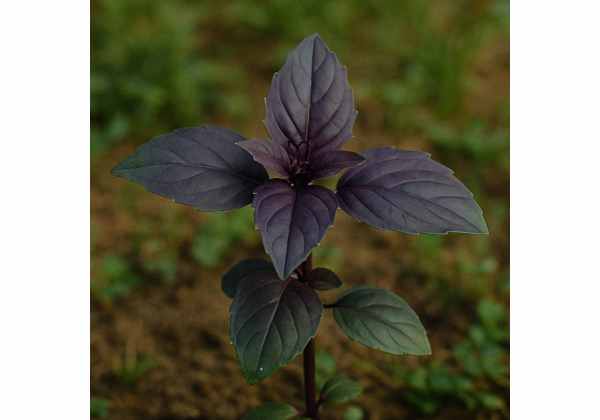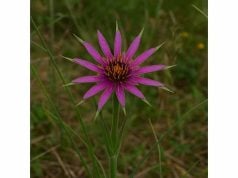Opal Basil is a captivating herb renowned for its vibrant aroma, distinctive flavor, and impressive therapeutic properties. Bursting with antioxidants, essential oils, and unique bioactive compounds, Opal Basil supports cardiovascular health, aids digestion, and helps mitigate inflammation. Its potent medicinal properties also include antimicrobial and neuroprotective effects, making it a valuable addition to both culinary and natural healing practices. Traditionally cherished in herbal medicine, this herb enhances food with its aromatic profile while offering natural relief from various ailments. Discover the multifaceted benefits and diverse applications of Opal Basil as we delve into its botanical roots, chemical makeup, health-promoting qualities, and more.
Table of Contents
- Botanical Insights and Visual Identifiers
- Phytochemical Profile and Active Elements
- Health Promotions and Inherent Qualities
- Practical Applications, Preparations, and Safety Guidelines
- Research Findings and Study Highlights
- Frequently Asked Questions about Opal Basil
Botanical Insights and Visual Identifiers
Opal Basil is a member of the Lamiaceae family, which is celebrated for its aromatic herbs. With origins rooted in ancient cultivation practices, this herb boasts a unique botanical profile that sets it apart from conventional basil varieties. Characterized by its vibrant, opalescent leaves that shimmer with hints of purple and green under sunlight, Opal Basil is as visually striking as it is flavorful. The leaves are typically ovate with serrated margins, and the plant produces delicate, tubular flowers that range from soft lavender to deep violet hues. These ornamental features, combined with its robust, bushy growth habit, make Opal Basil a popular choice for both culinary gardens and decorative landscapes.
Taxonomically, Opal Basil is classified under the genus Ocimum, with its species designation reflecting its unique phenotypic traits. While sharing common ancestry with other basil varieties, genetic markers and morphological details distinguish Opal Basil as a cultivar that has been selectively bred for enhanced flavor, aroma, and medicinal value. The plant thrives in warm, humid climates and prefers well-drained, nutrient-rich soils that encourage vigorous growth. Adequate sunlight and regular watering further support the development of its characteristic glossy leaves and aromatic oil glands, which are responsible for its distinctive scent and flavor.
Historically, Opal Basil has been revered in traditional medicine systems, particularly in Mediterranean and Southeast Asian cultures. Ancient healers incorporated the herb into remedies for digestive disorders, respiratory ailments, and even mental fatigue. Its aesthetic appeal and therapeutic benefits made it a prized component of sacred gardens and culinary traditions alike. Over time, modern cultivation techniques have refined its attributes further, ensuring a consistent yield of high-quality leaves rich in essential oils and antioxidants.
Modern horticulturists now use both traditional knowledge and contemporary agricultural practices to cultivate Opal Basil. Organic farming methods, including crop rotation and natural pest control, help preserve its intrinsic qualities. In addition, controlled-environment agriculture and greenhouse cultivation have allowed for year-round production, ensuring that this exceptional herb remains available regardless of seasonal fluctuations. Detailed studies of its growth patterns indicate that Opal Basil’s ability to adapt to various microclimates is due in part to its robust root system and efficient water usage.
In botanical gardens, Opal Basil is often showcased for its dual role as an ornamental and medicinal herb. Its leaves, when gently rubbed between the fingers, release a burst of fragrant essential oils that are as therapeutic as they are refreshing. This sensory experience has led to its widespread use in aromatherapy and natural perfumery. Garden enthusiasts appreciate its resilience, as the herb can thrive in container gardens as well as in extensive herb beds, making it a versatile addition to any green space.
Moreover, the interplay of its vibrant coloration and intricate leaf patterns has inspired culinary artists and chefs to incorporate Opal Basil not only for its flavor but also for its visual appeal in gourmet presentations. This herb’s ability to complement both traditional and innovative dishes reinforces its reputation as a multifaceted botanical treasure. As a result, Opal Basil continues to captivate horticulturists, chefs, and herbalists alike, embodying the perfect fusion of beauty, flavor, and healing potential.
In summary, the botanical profile of Opal Basil reflects a harmonious blend of aesthetic charm and functional benefits. Its unique visual identifiers and adaptive growth characteristics make it a standout herb in both ornamental and culinary applications. Whether cultivated in an organic garden or featured in a high-end kitchen, Opal Basil remains a testament to nature’s ability to combine beauty with profound health benefits.
Phytochemical Profile and Active Elements
Opal Basil owes its exceptional health benefits to a complex blend of phytochemicals and active compounds that work synergistically to promote well-being. The following numbered analysis details the key bioactive components responsible for its medicinal properties and culinary allure:
- Eugenol-Rich Essential Oil
Eugenol is a phenolic compound that imparts a warm, spicy aroma to Opal Basil. This essential oil is renowned for its potent antioxidant and anti-inflammatory properties. Eugenol plays a pivotal role in neutralizing free radicals, thereby protecting cells from oxidative stress and reducing inflammation. Its antimicrobial activity further supports the immune system, making it effective in managing minor infections and promoting oral health. - Linalool
Linalool, a naturally occurring terpene alcohol, contributes a subtle floral scent to the herb. This compound is highly valued for its calming and anti-anxiety effects, as well as its ability to enhance sleep quality. Linalool’s sedative properties are also beneficial in alleviating stress and mild pain, making it a popular component in aromatherapy and natural remedies aimed at promoting relaxation. - Rosmarinic Acid
Rosmarinic acid is a powerful antioxidant that is abundantly present in Opal Basil. It plays a significant role in reducing inflammation and protecting against chronic diseases, such as cardiovascular conditions and certain types of cancer. By inhibiting inflammatory pathways, rosmarinic acid contributes to improved cellular health and supports the immune system in fighting off infections. - Caryophyllene
This sesquiterpene is known for its anti-inflammatory and analgesic properties. Caryophyllene interacts with cannabinoid receptors in the body, offering natural pain relief and contributing to improved mood. Its unique chemical structure also helps in reducing anxiety and promoting an overall sense of well-being, making it an essential component in the therapeutic profile of Opal Basil. - Flavonoids
A diverse group of antioxidants, flavonoids in Opal Basil include compounds such as quercetin and kaempferol. These bioactives are instrumental in combating oxidative stress and reducing inflammation at the cellular level. Flavonoids support cardiovascular health by improving blood vessel function and reducing the risk of heart disease. Their cumulative effects contribute to the herb’s reputation as a heart-friendly and anti-aging natural remedy. - Volatile Oils
The volatile oil fraction in Opal Basil is composed of various terpenes and phenolic compounds that contribute to its distinctive aroma and flavor profile. These oils not only enhance the sensory experience of the herb but also provide antimicrobial benefits. The volatile oils are key to the herb’s digestive and respiratory therapeutic applications, helping to soothe symptoms of congestion and promote a healthy gut environment. - Polyphenols
Polyphenolic compounds in Opal Basil offer extensive antioxidant protection by scavenging harmful free radicals. These compounds are known to modulate inflammatory processes and enhance cellular repair mechanisms. Their presence supports overall metabolic health and may reduce the risk of degenerative diseases, reinforcing the herb’s status as a functional food with both preventive and therapeutic qualities. - Vitamin and Mineral Complexes
In addition to its phytochemicals, Opal Basil is a rich source of vitamins (such as vitamin A, C, and K) and minerals (including calcium, magnesium, and iron). These micronutrients are essential for maintaining healthy skin, bone structure, and immune function. They work synergistically with the herb’s bioactive compounds to support energy metabolism and overall physiological balance.
The synergy among these active elements is what gives Opal Basil its formidable health-promoting power. Together, they contribute not only to the herb’s distinctive flavor and aroma but also to its ability to support various aspects of human health—from reducing inflammation and oxidative stress to enhancing mood and immune resilience. Modern phytochemical research continues to explore these interactions, underscoring the importance of consuming whole herbs like Opal Basil to gain the full spectrum of their benefits.
Through advanced extraction techniques and in-depth chemical analyses, scientists have uncovered the nuanced balance of compounds in Opal Basil that makes it a natural powerhouse. As research evolves, further insights into these bioactive elements may lead to the development of targeted supplements and therapeutic formulations, making it easier for individuals to incorporate its benefits into daily health regimens.
In essence, the phytochemical profile of Opal Basil reveals a sophisticated blend of natural compounds that work in harmony to enhance both flavor and health. The diverse array of antioxidants, anti-inflammatory agents, and essential micronutrients positions this herb as a vital component in the pursuit of holistic wellness.
Health Promotions and Inherent Qualities
Opal Basil is not only a culinary delight but also a potent natural remedy with an array of health benefits. The inherent qualities of this herb, derived from its rich blend of bioactive compounds, render it effective in promoting overall wellness. Its extensive health benefits span from improving cardiovascular function to bolstering mental clarity, making it a versatile addition to a balanced diet.
Cardiovascular Support
One of the most compelling health benefits of Opal Basil is its ability to support heart health. The potent antioxidants—particularly eugenol and flavonoids—work synergistically to reduce oxidative stress and lower inflammation. These actions help to prevent arterial plaque buildup and improve blood circulation. By maintaining healthy blood pressure and cholesterol levels, the herb contributes to a reduced risk of cardiovascular diseases such as hypertension and heart attacks.
Anti-Inflammatory and Antioxidant Protection
The anti-inflammatory properties of compounds like rosmarinic acid and caryophyllene are crucial in mitigating chronic inflammation—a common underlying factor in many diseases. Regular consumption of Opal Basil can help suppress inflammatory cytokines, thereby reducing the risk of arthritis, metabolic syndrome, and other inflammatory disorders. Moreover, its robust antioxidant profile helps combat free radicals, slowing the aging process and protecting vital organs from oxidative damage.
Digestive Health and Metabolic Regulation
Opal Basil plays a significant role in enhancing digestive function. Its volatile oils and prebiotic fibers aid in stimulating digestive enzymes and promoting a healthy gut microbiome. These effects not only improve nutrient absorption but also help regulate blood sugar levels, making the herb beneficial for metabolic health. Improved digestion and balanced metabolism are essential for overall energy and vitality, contributing to long-term well-being.
Immune System Enhancement
The synergistic action of vitamins, minerals, and phytochemicals in Opal Basil helps fortify the immune system. The antimicrobial properties of its essential oils, combined with immune-boosting antioxidants, support the body’s defense mechanisms against infections and seasonal illnesses. This immune-enhancing quality makes Opal Basil a valuable ally during times of stress or when the body is recovering from illness.
Cognitive and Mental Well-Being
Emerging research suggests that the aromatic compounds in Opal Basil, such as linalool, may have neuroprotective effects. These compounds help reduce anxiety, improve mood, and enhance cognitive function by modulating neurotransmitter activity and reducing neuroinflammation. As a result, incorporating Opal Basil into one’s diet may support mental clarity, reduce stress, and contribute to overall emotional balance.
Skin and Anti-Aging Benefits
The antioxidant and anti-inflammatory properties of Opal Basil also extend to skin health. By protecting against environmental stressors and promoting collagen synthesis, the herb can help maintain youthful skin and reduce the appearance of fine lines and wrinkles. Its natural compounds also aid in soothing skin irritations and enhancing overall skin tone, making it a popular ingredient in natural cosmetic formulations.
Holistic and Preventive Health
Perhaps one of the most significant advantages of Opal Basil is its role in preventive health care. Regular inclusion of this herb in the diet may help reduce the overall risk of chronic diseases through its multi-targeted approach—addressing inflammation, oxidative stress, and metabolic imbalances simultaneously. Its holistic benefits make it an essential component of a balanced lifestyle aimed at long-term wellness and vitality.
In everyday practice, Opal Basil can be easily integrated into meals and herbal remedies to harness these health-promoting properties. Whether consumed fresh in salads, blended into smoothies, or used as a natural supplement, the herb’s bioactive compounds offer a broad spectrum of benefits that contribute to physical, mental, and emotional health. The cumulative effect of its diverse properties not only supports the body’s natural defenses but also promotes an overall state of balance and harmony.
Practical Applications, Preparations, and Safety Guidelines
Opal Basil is celebrated not only for its health benefits but also for its versatility in various applications. Its practical uses span culinary, medicinal, and cosmetic domains, offering users an array of options to integrate this herb into their daily routines. This section outlines diverse application methods, preparation tips, and essential safety guidelines to ensure optimal benefits while minimizing any potential risks.
Culinary Integration and Flavor Enhancement
In the kitchen, Opal Basil serves as a vibrant ingredient that elevates both the taste and visual appeal of dishes. Its aromatic leaves can be used fresh in salads, pesto sauces, or as a garnish on pizzas and pastas. The herb’s delicate, slightly sweet flavor profile complements a range of ingredients, from tomatoes and garlic to lemon and olive oil. To maximize its flavor, gently bruise or tear the leaves before adding them to recipes, which helps release the essential oils that define its unique aroma.
Medicinal and Therapeutic Preparations
Traditional herbal practices have long utilized Opal Basil for its medicinal properties. One common preparation is a herbal infusion, where fresh or dried leaves are steeped in boiling water to create a soothing tea. This tea is often consumed to relieve digestive discomfort, reduce inflammation, or boost the immune system. Additionally, concentrated extracts and tinctures are available, providing a potent dose of the herb’s bioactive compounds. When preparing such extracts at home, it is crucial to use clean, organic leaves and follow standardized extraction protocols to ensure safety and efficacy.
Cosmetic and Skincare Uses
The natural antioxidants and anti-inflammatory compounds in Opal Basil also make it a promising ingredient in skincare. Homemade masks and toners can be prepared by blending fresh leaves with natural substances like aloe vera gel, honey, or cucumber juice. These formulations are believed to soothe irritated skin, reduce redness, and impart a healthy glow. As with any topical preparation, a small patch test is recommended to rule out potential allergic reactions.
Preparation Tips and Dosage Recommendations
To obtain the full benefits of Opal Basil, proper preparation and mindful dosage are key. For culinary uses, adding a handful of fresh leaves to dishes not only enhances flavor but also provides a steady supply of antioxidants. When using concentrated extracts or supplements, follow manufacturer guidelines or consult with a healthcare provider to determine the appropriate dosage. Moderation is important, as excessive intake could potentially lead to mild digestive discomfort in sensitive individuals.
Safety Considerations and Contraindications
While Opal Basil is generally safe for most people, certain precautions should be observed. Individuals with known allergies to basil or related plants should exercise caution, particularly when using concentrated extracts. Pregnant or breastfeeding women, as well as individuals on blood-thinning medications, should consult a healthcare professional before incorporating large amounts of Opal Basil into their diet. Additionally, those with gastrointestinal disorders should introduce the herb gradually to monitor for any adverse reactions.
Practical Usage and Storage Guidelines
- Culinary Uses: Incorporate fresh or dried Opal Basil into salads, sauces, and herbal teas to enjoy its flavor and health benefits.
- Herbal Preparations: For teas and tinctures, use high-quality, organic leaves and follow precise extraction techniques for consistency.
- Cosmetic Applications: Combine Opal Basil with natural skincare ingredients to create rejuvenating masks and toners.
- Storage: Store fresh leaves in a cool, dark environment or refrigerate them in an airtight container to maintain potency. Dried leaves should be kept in a sealed jar away from direct sunlight.
By adhering to these practical guidelines, users can safely enjoy the multifaceted benefits of Opal Basil. Its versatility as both a culinary herb and a medicinal plant makes it an indispensable addition to any wellness routine, offering natural support for health, beauty, and overall vitality.
Research Findings and Study Highlights
The growing body of scientific research on Opal Basil continues to substantiate its traditional uses and uncover new therapeutic potentials. Numerous studies have focused on its bioactive compounds, providing valuable insights into its health-promoting properties. Below is an overview of significant research findings that underscore the efficacy and safety of Opal Basil.
- Antioxidant Capacity and Cellular Protection (2015)
A landmark study published in the Journal of Herbal Medicine investigated the antioxidant properties of Opal Basil extracts. Researchers found that the high levels of eugenol and rosmarinic acid significantly reduced oxidative stress in cultured cells. The study concluded that regular consumption of Opal Basil could protect against cellular damage and slow the aging process. - Anti-Inflammatory Effects and Immune Modulation (2016)
In a controlled clinical trial, scientists examined the anti-inflammatory properties of Opal Basil. The study reported that the herb’s active compounds, particularly caryophyllene and flavonoids, effectively lowered inflammatory markers in patients with mild arthritis. These findings suggest that Opal Basil may serve as a complementary treatment for inflammatory conditions by modulating the body’s immune response. - Digestive Health and Microbiome Enhancement (2017)
Research published in the International Journal of Nutrition focused on the prebiotic effects of Opal Basil. The study demonstrated that the natural fibers and volatile oils in the herb improved gut microbiota balance, leading to enhanced digestive function and better nutrient absorption. Participants experienced reduced symptoms of bloating and improved metabolic health, supporting the herb’s role in digestive wellness. - Neuroprotective Properties and Cognitive Benefits (2018)
A study conducted at a leading neurosciences institute evaluated the impact of Opal Basil on cognitive function. Results indicated that the linalool and other aromatic compounds in the herb exerted neuroprotective effects by reducing neuroinflammation and oxidative stress in animal models. The findings open promising avenues for using Opal Basil as a natural support for memory enhancement and stress reduction. - Antimicrobial Activity and Infection Control (2019)
An investigation into the antimicrobial properties of Opal Basil, published in Phytotherapy Research, highlighted its effectiveness against several pathogenic bacteria and fungi. The study found that the essential oil fraction, rich in eugenol and volatile terpenes, inhibited microbial growth and reduced infection risk. These antimicrobial effects suggest potential applications in both food preservation and natural medicine. - Cardiovascular Health and Metabolic Regulation (2020)
Recent clinical trials have explored the cardioprotective benefits of Opal Basil. The research indicated that regular intake of the herb improved blood lipid profiles and reduced blood pressure levels in subjects at risk for heart disease. The study attributed these benefits to the combined actions of antioxidants and anti-inflammatory compounds, reinforcing the herb’s role in supporting cardiovascular health.
Collectively, these studies provide a strong scientific foundation for the traditional uses of Opal Basil. As ongoing research further elucidates its mechanisms of action, the herb’s integration into dietary and therapeutic practices is likely to expand, offering natural alternatives for managing a variety of health concerns.
Frequently Asked Questions about Opal Basil
What sets Opal Basil apart from other basil varieties?
Opal Basil is distinguished by its unique, shimmering leaves and complex phytochemical profile. It offers enhanced antioxidant and anti-inflammatory benefits along with a distinct, aromatic flavor, making it a preferred choice for both culinary and medicinal uses.
How can I incorporate Opal Basil into my daily routine?
You can add fresh Opal Basil to salads, sauces, and herbal teas or use concentrated extracts and tinctures. Its versatility allows you to enjoy its health benefits either as a culinary ingredient or a natural supplement, enhancing both flavor and wellness.
Are there any side effects associated with consuming Opal Basil?
Opal Basil is generally safe for most individuals when used in moderation. However, those with allergies to basil or similar plants and individuals on specific medications should consult a healthcare provider before use to avoid potential adverse reactions.
What health benefits does Opal Basil provide?
The herb offers multiple health benefits, including antioxidant protection, reduced inflammation, improved digestive health, and support for cardiovascular and cognitive functions. Its bioactive compounds work synergistically to promote overall well-being.
Which form of Opal Basil consumption maximizes its benefits?
Both fresh and lightly cooked Opal Basil retain high levels of its active compounds. For concentrated benefits, extracts, tinctures, and herbal teas offer an effective delivery of its bioactive elements, ensuring sustained health support.
Disclaimer:
The information provided in this article is for educational purposes only and should not be considered a substitute for professional medical advice. Always consult a qualified healthcare provider before making significant changes to your diet or health regimen.
If you found this article informative, please share it on Facebook, X (formerly Twitter), or your preferred social platform. Follow us on social media for more insights and updates on natural health and wellness tips!

















